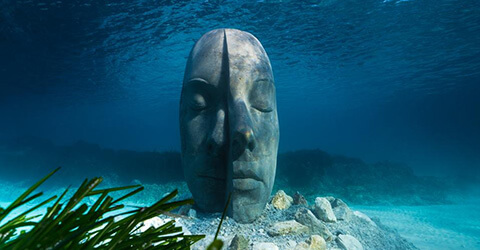Jason deCaires Taylor is an Environmentalist, Sculptor and Professional Underwater Photographer. He was the first of a new generation of artists to alter the concept of land art to a different medium: Marine Environment. His evolving sculptures support the lifecycle of the aquatic organisms as they are made from pH neutral cement, which shows Taylor’s concern goes beyond just the aesthetics of his artworks. He has opened the first underwater sculpture Museum globally and continues to share his art with the people.
Taylor is the only son of a British father and a Guyanese mother. As a kid, he travelled a lot and grew up between Europe and Asia. From childhood he was drawn to the ocean that led to his artistic masterpieces showcasing its beauty. He says, “My parents would often rent a boat during the weekend and we would explore pristine islands in Thailand and Malaysia. I was very fortunate to have had such amazing experiences at the early age of seven, or eight. It left an everlasting impression on my mind, and made me want to explore both artistic boundaries and the vast sea.”
According to Taylor, the ocean is an incredible space where he can disconnect, a silent world where one can experience complete solitude with one’s thoughts. He added, “It’s like crossing a line into another world that is completely detached from our own. It’s a very special place indeed.” To connect with the ocean deeper, he took up scuba diving at 18 and became a fully qualified scuba instructor in 2002.
Simultaneously, Taylor decided to pursue his passion for Fine Arts and graduated from Camberwell College of Arts Institute of London in 1998 with an Honours degree in Sculpture and Ceramics. After college, he explored several different jobs, including working as a diving instructor. Over the years, he fused his love for art and the ocean together that led him to think about how the sea could be a unique medium to showcase art and how artworks can be set up underwater to create artificial reefs.
With that vision in mind, he decided to build an underwater sculpture park in the Caribbean. Taylor explained, “I started off small in an area that had been decimated by a hurricane. By building the park, I wanted to rejuvenate the area and draw people’s attention to natural fragile areas. I’ve made around 800 underwater sculptures since then.”
He continued, “my projects are not just about their artistic aspect, but also about conserving the marine environment. So my works have several different goals. On a practical level, they create artificial reefs, providing an alternative surface area for corals and different creatures to live on, as well as habitat spaces where creatures can take refuge.”
The main aim is to draw people away from fragile marine habitats and draw them deeper into the sea. He added, “It’s a hidden world, often forgotten. Through my work, I want to draw attention to the many issues affecting our oceans, whilst highlighting its incredible fragility and wonder.”
Taylor brought his dream to life by creating the world’s first underwater sculpture park in 2006. According to National Geographic, it opened in the West Indies and now represents one of the Top 25 Wonders of the World.
Talking about its completion, he says, “I enjoyed seeing more and more divers visit and appreciate the Museum. But what I loved most was seeing the site being colonised by the area’s wildlife, integrating naturally with the marine environment.”
Emboldened by his victories, he continued to work on more projects, and in 2009, he co-founded MUSA, a monumental Museum of underwater sculptures containing 500 of his pieces. These are mainly individual installations with live corals taken from the areas with the damaged reef. Taylor’s most significant artwork is called The Silent Evolution. It was installed in MUSA in 2010, and it features 450 statues of people in various positions, expressing a wide range of emotions.
He then ventured into new territory with the installation of Museo Atlántico, which is around 400 metres from the shoreline of Las Coloradas, Mexico and approximately 12-14 metres deep. Speaking about the project, he says, “This island is quite special, because it has a long history of environment-related art, with many land installations that work closely with the environment. So Lanzarote was an ideal spot to realise this project.”
The Museum consists of 12 different installations, with around 300 works interspersed within the Museum’s other zones. Visitors come into the Museum with a trained guide and are taken for a tour viewing each exhibit. At the end of their tour, they are taken to the exit point back to the safety of their boat.
Taylor’s fascinating sculptures display the relationship between humans and nature surrounding them. The dull concrete is brought to life by his pieces with the colourful hues of the reefs. His art is meant to become one with nature to showcase its true beauty. Taylor works closely with marine scientists and ensures that his materials are eco-friendly and naturally responsive. They also promote the health of local ecosystems since they are positioned in carefully planned locations, according to the tidal patterns and coral geography. It will necessarily go through various transformations, but its immortality lies precisely in this magical flexibility.
In conclusion, Taylor says, “It’s all about having a different outlook on our own lives. I think that incorporating modern concepts into this sort of dynamic underwater environment can enable us to briefly step back from our own lives and to look at ourselves in a different context.”







